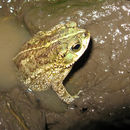pt-BR
nomes no trilho de navegação


Rhinella fernandezae is a species of toad in the family Bufonidae that is found in Argentina, Brazil, Paraguay, and Uruguay. Its natural habitats are subtropical or tropical dry lowland grassland, subtropical or tropical seasonally wet or flooded lowland grassland, intermittent freshwater marshes, coastal freshwater lagoons, arable land, pastureland, plantations, and seasonally flooded agricultural land.
{{cite journal}}: CS1 maint: multiple names: authors list (link) Rhinella fernandezae is a species of toad in the family Bufonidae that is found in Argentina, Brazil, Paraguay, and Uruguay. Its natural habitats are subtropical or tropical dry lowland grassland, subtropical or tropical seasonally wet or flooded lowland grassland, intermittent freshwater marshes, coastal freshwater lagoons, arable land, pastureland, plantations, and seasonally flooded agricultural land.
El sapito de panza amarilla (Rhinella fernandezae), también llamado: sapito de jardín de Fernández, es una especie de anfibio perteneciente a la familia Bufonidae. Se lo encuentra en el sector este del cono sur de Sudamérica.[1]
En el año 1957 el herpetólogo argentino José María Gallardo describe para la ciencia este taxón, originalmente como una subespecie de Bufo granulosus.[2]
Se lo encuentra, desde el nivel del mar hasta los 600 msnm, en Brasil en el estado de Río Grande do Sul; en el sur del Paraguay; en el Uruguay en los departamentos de: Canelones, Colonia, Montevideo, Río Negro, y San José; y en la Argentina, en las provincias de: Buenos Aires, Córdoba, Corrientes, Entre Ríos, La Pampa, y Santa Fe.[3]
Mide entre 7 y 8 cm. Como defensa, posee glándulas parótidas que segregan una secreción tóxica. Para su protección, cava con sus patas posteriores cuevas de 20 a 30 cm de profundidad.
Sus hábitats naturales son sabana húmeda, matorrales subtropicales húmedos, praderas templadas o subtropicales estacionalmente húmedas o inundadas de tierras bajas, pantanos de agua dulce temporarios, cultivos, y jardines suburbanos.
Se alimenta de insectos, arácnidos, moluscos, y crustáceos.[4]
Desde octubre hasta marzo, luego de fuertes lluvias, los machos cantan semisumergidos en lagunas permanentes o semipermanentes; en el fondo de estas, las hembras depositan sus huevos en ristras gelatinosas, luego del amplexo visible tanto de día como de noche. Cuando los renacuajos abandonan el agua cuentan con sólo 1 cm de longitud.
Sufre una alta mortandad a causa de aplastamientos por automóviles. Si bien podrían estar afectándolo la contaminación de los humedales causada por el escurrimiento de agroquímicos, vertidos industriales, y de asentamientos humanos, aún son amenazas localizadas, siendo una especie abundante, por lo que la IUCN la categoriza como de «Preocupación menor».
[1] Patricia Narvaes, Axel Kwet, Débora Silvano, Esteban Lavilla, José Langone 2004. Rhinella fernandezae. In: IUCN 2011. IUCN Red List of Threatened Species. Version 2011.1. . Consultado el 12 de julio de 2011.
El sapito de panza amarilla (Rhinella fernandezae), también llamado: sapito de jardín de Fernández, es una especie de anfibio perteneciente a la familia Bufonidae. Se lo encuentra en el sector este del cono sur de Sudamérica.
Rhinella fernandezae Rhinella generoko animalia da. Anfibioen barruko Bufonidae familian sailkatuta dago, Anura ordenan.
Rhinella fernandezae est une espèce d'amphibiens de la famille des Bufonidae[1].
Cette espèce se rencontre en dessous de 600 m d'altitude[1],[2] :
Les mâles mesurent de 38,2 à 67,3 mm et les femelles de 40 à 76,4 mm[3].
Cette espèce est nommée en l'honneur de Kati Fernández[4].
Rhinella fernandezae est une espèce d'amphibiens de la famille des Bufonidae.
Rhinella fernandezae é uma espécie de anfíbio da família Bufonidae. Pode ser encontrada no Brasil, Argentina, Uruguai e Paraguai.[2]
Rhinella fernandezae é uma espécie de anfíbio da família Bufonidae. Pode ser encontrada no Brasil, Argentina, Uruguai e Paraguai.
Chaunus fernandezae là một loài cóc trong họ Bufonidae. Nó được tìm thấy ở Argentina, Brasil, Paraguay, và Uruguay. Các môi trường sống tự nhiên của chúng là đồng cỏ khô nhiệt đới hoặc cận nhiệt đới vùng đất thấp, đồng cỏ nhiệt đới hoặc cận nhiệt đới vùng ngập nước hoặc lụt theo mùa, đầm nước ngọt có nước theo mùa, phá nước ngọt ven biển, đất canh tác, vùng đồng cỏ, các đồn điền, và đất nông nghiệp có lụt theo mùa.
Chaunus fernandezae là một loài cóc trong họ Bufonidae. Nó được tìm thấy ở Argentina, Brasil, Paraguay, và Uruguay. Các môi trường sống tự nhiên của chúng là đồng cỏ khô nhiệt đới hoặc cận nhiệt đới vùng đất thấp, đồng cỏ nhiệt đới hoặc cận nhiệt đới vùng ngập nước hoặc lụt theo mùa, đầm nước ngọt có nước theo mùa, phá nước ngọt ven biển, đất canh tác, vùng đồng cỏ, các đồn điền, và đất nông nghiệp có lụt theo mùa.